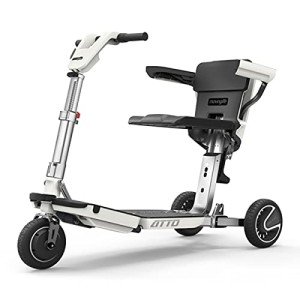Understanding Mobility Devices: Enhancing Independence and Quality of Life
In today's fast-paced world, the desire for mobility is universal. However, fold up scooters or age-related obstacles can impede movement, resulting in an ongoing search for support. Mobility devices function as necessary tools to enhance self-reliance, improve lifestyle, and allow people to engage totally in their communities. This article supplies a comprehensive introduction of mobility devices, including their types, features, selection criteria, and more.
Types of Mobility Devices
Mobility devices range from simple aids to complex devices, customized to satisfy various needs. Below is a table summarizing common types of mobility devices:
| Type of Device | Description | Perfect For |
|---|---|---|
| Walkers | Four-legged assistance devices that provide exceptional stability while strolling. | People needing extra support. |
| Walking canes | Single or three-legged sticks that enhance balance and support walking. | Those with slight mobility troubles. |
| Wheelchairs | Seats mounted on wheels, offered in manual and electric variations. | People with restricted or no mobility. |
| Scooters | Electric automobiles designed for outside usage and ease of navigation. | Those who can't walk long distances. |
| Crutches | Devices that assist people move weight away from a hurt leg. | Individuals recuperating from leg injuries. |
| Rollators | Walkers with wheels, seats, and brakes for boosted mobility. | Users requiring rest choices while strolling. |
| Lift Chairs | Reclining chairs that assist users in standing and sitting down. | Seniors or those with mobility constraints. |
| Mobility Scooters | Small electric lorries for restricted mobility, often utilized outdoors. | People requiring support over cross countries. |
Key Features of Mobility Devices
When selecting a mobility device, a number of key features need to be considered to make sure optimal functionality and ease of usage:
- Weight Capacity: Understanding the device's weight constraint is crucial for safety and effectiveness.
- Adjustability: Devices should be adjustable in height and width to fit the user conveniently.
- Mobility: Lightweight and foldable choices are important for users who travel or need transport.
- Stability and Safety: Look for features like anti-tip wheels and sturdy structures to enhance security.
- Reduce of Use: Simple mechanisms and user-friendly styles can make a substantial distinction in everyday use.
- Convenience: Ergonomic designs and padded seats can improve the user experience.
Selecting the Right Mobility Device
Selecting the ideal mobility device can be an overwhelming task. Here are some steps to assist the decision-making procedure:
- Assess Needs: Evaluate the individual's mobility difficulties and daily activities.
- Seek advice from a Professional: Engage health care experts who can offer suggestions based upon the individual's physical condition.
- Trial Options: If possible, trial different devices to figure out comfort and functionality.
- Review Budget: Consider the expense of the gadget, consisting of any additional functions or adjustments needed.
- Research Options: Determine the best brands and designs by checking out reviews and comparisons.
Table: Comparative Analysis of Popular Mobility Devices
| Gadget | Advantages | Disadvantages |
|---|---|---|
| Walkers | Outstanding stability, promotes strolling. | Bulky, may limit movement in small areas. |
| Walking sticks | Lightweight, enhances balance. | May not offer enough support for severe mobility concerns. |
| Wheelchairs | Ideal for those with considerable mobility limitations. | Can be cumbersome, specifically in indoor environments. |
| Scooters | Great for outside usage, simple to maneuver. | Minimal indoor usability, heavier. |
| Rollators | Offers rest option, simple to move. | May require more space than conventional walkers. |
| Raise Chairs | Comfy, assists shift from sitting to standing. | More pricey, larger footprint. |
Regularly Asked Questions (FAQs)
1. What is a mobility gadget?
A mobility device is any tool developed to help individuals in moving and navigating their environment. This consists of walkers, wheelchairs, scooters, and crutches.
2. How do I know which mobility gadget is best for me?
Consider your particular mobility obstacles, physical capabilities, and way of life requirements. Consulting with healthcare specialists can likewise provide customized recommendations.
3. Are mobility devices covered by insurance?
Lots of insurance plans, including Medicare, may cover specific mobility devices. It's crucial to inspect with your insurance coverage company for particular protection information.
4. Can I rent a mobility device rather of buying one?
Yes, numerous medical supply shops and drug stores provide leasings for mobility devices. This alternative is advantageous for people with momentary mobility concerns.
5. How can I preserve my mobility gadget?
Routine maintenance is vital. It consists of cleaning up the device, looking for wear and tear, and guaranteeing all parts are working properly.
The Impact of Mobility Devices on Quality of Life
Mobility devices considerably improve the lifestyle for individuals with limited mobility. They foster self-reliance, motivate social interaction, and enhance access to essential services and leisure activities.
- Increased Independence: Users can browse their communities, participate in occasions, and engage in pastimes without counting on others.
- Social Engagement: Mobility devices help with involvement in celebrations, thereby combating sensations of seclusion.
- Boosted Safety: Devices provide stability and decrease the danger of falls, promoting user self-confidence.
Mobility devices are more than just tools for movement; they are gateways to self-reliance and quality living. By comprehending the various types of mobility aids readily available, their key functions, and factors to consider for picking the right gadget, people can make informed choices about their mobility requires. Ultimately, the right mobility gadget can result in a more active, fulfilling life. Whether it's a walker, wheelchair, or scooter, the right choice contributes significantly to enhancing the mobility and self-reliance of users.

